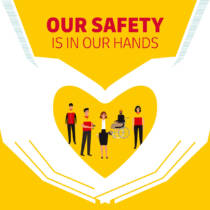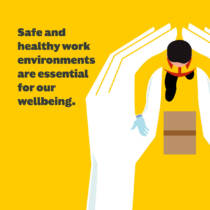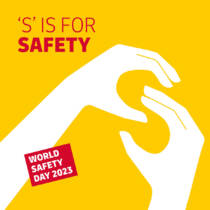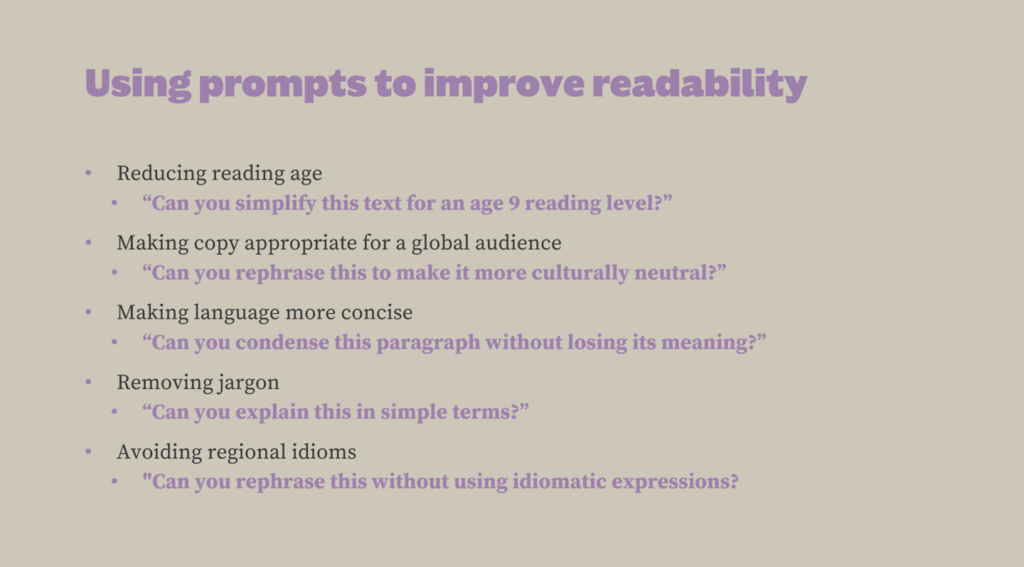Five AI trends we expect to see in 2024
By Sally Pritchett
CEO
Looking ahead to 2024, what AI trends can we anticipate?
This year, we have witnessed the rapid growth of AI. New platforms, applications, and software have emerged for almost every industry, including creative communications. However, in the ever-evolving landscape of AI, what trends can we expect to see in 2024?
Increased legislation
Nations across the globe are forming comprehensive AI policies in order to set regulations, drive innovative growth, and help ensure everyone can benefit from AI. As AI continues to advance, expect to see further guidelines and regulations introduced, including laws to prevent harmful content such as deepfakes. The speed at which AI evolves is set to continue in 2024, so we expect legislation will continually evolve to keep up with this new technology.
The importance of ethical AI
As AI becomes more widely adopted in 2024, we will see a continued focus on it being developed and used in a responsible way. There are already concerns about AI biases, plagiarism, accuracy, and a lack of transparency. However, despite these concerns, 73% of users trust content created by generative AI. This worrying statistic highlights how important it is that AI is used ethically. As we head into 2024, experts expect to see an increased interest in AI ethics education.
In the communications industry, honesty, accuracy and inclusivity are vital, so it’s important that we use AI in a responsible way. We believe it’s time for the communications industry to take the lead and set its own guidelines for ethical AI usage.
AI-enhanced creativity
AI is rapidly becoming a collaborative partner to people in many different job roles across a vast range of industries, including creative communications. Platforms such as Midjourney and Adobe Firefly have brought AI capabilities to the creative industry with tools such as generative fill. Whilst there is no replacement for human creativity, these tools can help creatives work more efficiently. As we move through 2024, expect to see these tools more widely adopted and new capabilities introduced.
The next generation of generative AI
Generative AI has advanced rapidly this past year, and the pace is set to continue. In 2024, generative AI is expected to advance further, from language model-based chatbots such as ChatGPT to video creation tools. Experts predict that AI applications and tools will become more powerful and user-friendly, new applications and capabilities will appear, and the difference between human and AI-generated content will become trickier to determine. Furthermore, we will start to see AI integrated into commonly used applications, such as the introduction of Microsoft 365 Copilot across the Microsoft 365 product suite.
AI as an intelligent assistant
As AI continues to be integrated into more commonly used applications and software, it is expected that it will start to become an intelligent assistant to us in our everyday work. From summarising lengthy PDF documents to grammar checking, and highlighting social media trends to researching hot topics, AI can help us work more efficiently. However, while AI offers opportunities to streamline processes and increase efficiency, we must still ensure responsible and ethical use.
Navigating AI together: overcoming bias and achieving inclusion
With the AI revolution upon us, we’ve been facilitating regular roundtable discussions to support communicators in navigating this change together.

In our next session we will examine the issue of the biases embedded in AI and explore how we can mitigate this bias and harness AI tools to foster greater inclusion and authentic representation.
Let’s continue Navigating AI Together, ensuring responsible, ethical, and inclusive AI usage in our communication practices.
Sustainable production: tips for greener communications in 2024
By Sally Pritchett
CEO
Get insights and actionable tips on sustainable production for greener communications in 2024.
Reading anything about climate change can make us feel helpless and overwhelmed by the size of the challenges, but as a B Corp we believe in continuous progress and action over words. We’re delighted to share some of our learnings and tips to help others make everyday swaps and changes in the right direction.
Sustainable production purchasing
Here are three easy ways you can pledge to make your communications production more sustainable:
Choosing sustainable paper
To reach your audience and communicate in a way that is best for them, sometimes you need to print. If you make the right printing choices, the often-held belief that digital communications are greener than print isn’t always true. Where possible insist on FSC or PEFC-accredited paper sources, this means that production has supported responsible forest management, prevents illegal logging and protects wildlife and local communities.
Go local, where you can
When possible, try to reduce the air miles of your communications by insisting on local production. This may increase prices on some lower-quality products, but it can also come with the benefits of faster turnaround times, avoiding long shipping times.
Switch to B Corp or accredited sustainable suppliers
Whether it’s B Corp, Planet Mark, or ISO 14001, there are many verified accreditations that organisations can go through to prove their commitment to sustainability. Try to fill your supply chain with organisations who are committed to making a difference and taking sustainability seriously.
Responsible production and consumption
Here are three straightforward strategies to minimize your communications consumption while prioritising sustainable production practices.
Look after your stock
It’s common for boxes of promotional giveaways to be sent off to events and never return, leading to avoidable waste. Plan ahead and establish a process to facilitate easy returns. This ensures that unused items come back into stock safely, ready to be reused for future events. If you’re managing a store of items, make a point of knowing what goes in and out so that you can protect stock and only re-order when needed. It’s useful to share the value of items with your stakeholders so they can better understand the budget impact of wastage.
Make your giveaways practical and useful
Make sure that promotional items are as useful, practical, and long-lasting as possible to prevent further wastage. Hopefully long gone are the days of frivolous gimmicky single-use giveaways. A simple way to check is to ask yourself ‘Would I use this?’ or ‘How long would I keep this?’.
Think differently about how you give things away
We’re all used to event goody bags and placing giveaways on chairs or at every table setting, but this can contribute to unnecessary waste. Attendees often leave items behind, which may end up in the bin or linger at the bottom of bags, eventually being discarded at home. Let’s commit to a different approach by offering attendees the option to choose whether they want to take the giveaway.
Try having a ‘goodbye’ table where people can choose what they’d like to take. This reduces the waste and makes attendees value the items they pick up more. You could also try gamifying giveaways, making attendees work to earn the ‘merch’ and in doing so increasing their connection with it.
If you automatically send items out to data lists, commit to reviewing your data more often to make sure you’re not sending items to out-of-date contacts.
Promotional merchandise can play a great role in building loyalty and has longevity in comparison to many other techniques, so it can’t always be something to avoid altogether but if you’re still producing single-use, plastic pens then it’s time to rethink your approach to branded merchandise.
Sustainable production swaps
Here are three sustainable replacement items you might be able to introduce into your 2024 communications plans to reduce less sustainable alternatives:
Notepads made with apple peel covers
Crafted from apple peel, vegetable fibers, and sustainable pulp, these Appeel notebooks feature FSC-certified ivory-tinted apple paper, providing a personalised touch.
Notepads made from stone
Opt for stone paper notepads for a 100% tree-free and water-resistant alternative, saving water in the production process.
Compostable pencils with seeds
Personalised pencils made from sustainably harvested wood offer a lead-free, graphite core. After use, these pencils can be planted to grow into various plants, adding a touch of sustainability to your giveaways.
We know how tricky it can be to align promo and print with your commitment to sustainability. Let us guide you to making more environmentally responsible choices.
Attract and retain top talent: the power of purpose and culture
By Sally Pritchett
CEO
When culture, honest communication, and purpose are essential, how can communicators attract and retain top talent?
Ever find yourself lost in the hustle, wondering where all your time goes? The busier life gets, the more crucial it becomes to reflect on how we spend our time. After all, time is precious, and optimising it is an art.
In a video earlier this year, our Commercial Director reflected on the time they had devoted to a battle they know all too well – the Talent War. To be exact, 650+ hours in 2022 alone, navigating the competitive landscape of recruitment, CVs, interviews, and the rollercoaster of onboarding and, unfortunately, occasional offboarding.
While some say the Talent War is over due to economic instability, the truth is that many employees are still seeking purpose in their work. Moreover, the growing differences in generational expectations regarding the workplace is creating challenges in attracting, and retaining, top talent. These shifts show that finding and keeping top talent goes beyond just economic factors.
When workplace culture, honest communications, and company purpose are vital to today’s employees, what can communicators do to attract and retain top talent?
Engage with hearts and minds
Attracting talent boils down to one thing: opening and engaging with the hearts and minds of potential candidates. Let’s take a trip back to 2001 when Apple revolutionised the music industry with the iPod. What set it apart wasn’t specs and features but the simplicity and clarity of its message – “1,000 songs in your pocket.” In today’s competitive job market, what’s your unique selling proposition? Flexible working, competitive salaries, and employee benefits while all essential to many job seekers, don’t define a company in the long run.
The power of purpose
The key to success? Define what sets your company apart, and that comes down to your company’s purpose. Employee motivations are evolving, and companies addressing this shift are few and far between. People crave purpose in their work. Statistics show 75% of the workforce will be ethically-minded millennials by 2025. Placing purpose front and centre, and integrating it into job descriptions and candidate discussions can help you connect with the right candidates and sidestep those where synergy is lacking.
Building a magnetic culture
It costs to attract, engage, and grow your people. The solution? Building a magnetic culture. A business with a magnetic culture draws people in, creates unity, and retains the best talent. And a thriving culture boosts productivity, improves customer service, and reduces turnover costs. In retention, go beyond the basics.
Be like Apple – stand apart. Focus on creating a thriving culture, driven by your purpose, to make your business different.
Whether you’re refreshing your recruitment communications or nurturing a united workplace culture, we can provide the support you need.
How to cultivate a safety-first culture
By Sally Pritchett
CEO
How to sustain a safety-first culture across large organisations
Safe and healthy work environments are essential for our wellbeing. When we feel physically and psychologically safe at work, we are more likely to feel engaged, motivated and can thrive in our roles.
To maintain a safe workplace, businesses need to ensure that employees always keep health & safety guidance front of mind. Yet it can be difficult to ensure that more educational, safety-focused messaging cuts through the noise of other internal comms, especially across large organisations.
It’s also important that health & safety communications are inclusive to ensure that the message reaches every person in the organisation. Businesses need to use plain, accessible language that is easy to understand, but still be able to engage the audience.
To understand how to strike the balance in your safety comms, here’s how we approached our award-winning health & safety campaign for DHL Supply Chain.
Case study: Motivating DHL Supply Chain employees to put safety first
Located across 60 countries with diverse languages and cultures, DHL Supply Chain were keen to elevate and standardise health & safety across their business – to make sure it was as important as other key initiatives.
They wanted to find a way to foster safe behaviours, responsibility and adherence to best practices across all countries, cultures, and languages.
We were tasked with refreshing their messaging around health & safety, emphasising that safety is a collective responsibility involving all employees. They needed a global standardized framework, messaging and toolkit for communications, to better support their safety-first culture.
So, how did we motivate employees to put safety first for themselves and each other?
1. Kept it simple
To work across 60 countries, we needed an idea that was simple, memorable, culturally appropriate and easy to understand.
2. Got hands on
We developed “Our Safety is in Our Hands” to convey that all employees are accountable for their own safety and that of their colleagues.
3. World Safety Day launch
We created reference pocket guides, a concise explainer video, warehouse posters, and assets for an internal app to spread the message across the workforce.
4. Monthly focus
To fully embed the message, we rolled out a 12-month campaign focusing on a different health & safety element each month – including topics such as wellbeing and mental health, personal safety, and transport safety.
As a result of the campaign, DHL Supply Chain observed a significant cultural shift which has led to improved health & safety practices right across their business.
Let’s talk about elevating health & safety comms and putting wellbeing first at your workplace.
Navigating AI Together: Accessibility, transparency and voice cloning
By Sally Pritchett
CEO
We're uniting communicators to navigate the ever-evolving AI landscape. Here, we share insights from our most recent 'Navigating AI Together' roundtable.
AI can be a scary topic. For many the opportunity for a big productivity boost is sitting alongside fears around role replacement and the devaluing of skills. When we heard these concerns from fellow communicators, we knew we needed to help. Our ‘Navigating AI Together’ forum is supporting communicators to manage the transition to AI together, safely, ethically, and with positive and open mindsets.
In our most recent session of Navigating AI Together, we delved into the current state of AI, strategies for enhancing communication accessibility and inclusivity, the importance of AI transparency, and even took a deep dive into the fascinating realm of AI voice cloning.
In previous sessions we have:
- Explored the role AI in communications, including the challenges and opportunities.
- Shared a guide to prompting, tailored to communication professionals.
- Discussed the creation of policies for responsible AI usage and user accountability.
- Provided a review of Midjourney.
- Examined AI-assisted video creation.
The current state of AI
In the latest ‘Navigating AI together’ session we reflected on the rapid growth of AI, especially with the recent emergence of generative AI, symbolised by ChatGPT’s meteoric rise. With the genie now out of the bottle, the AI landscape is evolving exponentially, leading to an influx of uses, applications, and platforms. However, experts are suggesting that we may not experience another technological leap of this magnitude anytime soon. Our collective responsibility is now to maximize AI’s potential while adhering to clear usage guidelines and responsible practices.
Notably, a concerning statistic has emerged, revealing that 73% of users trust content generated by generative AI. This really shows the importance of close supervision in AI-generated content, especially in the communication field, where reliability and truthfulness are paramount.
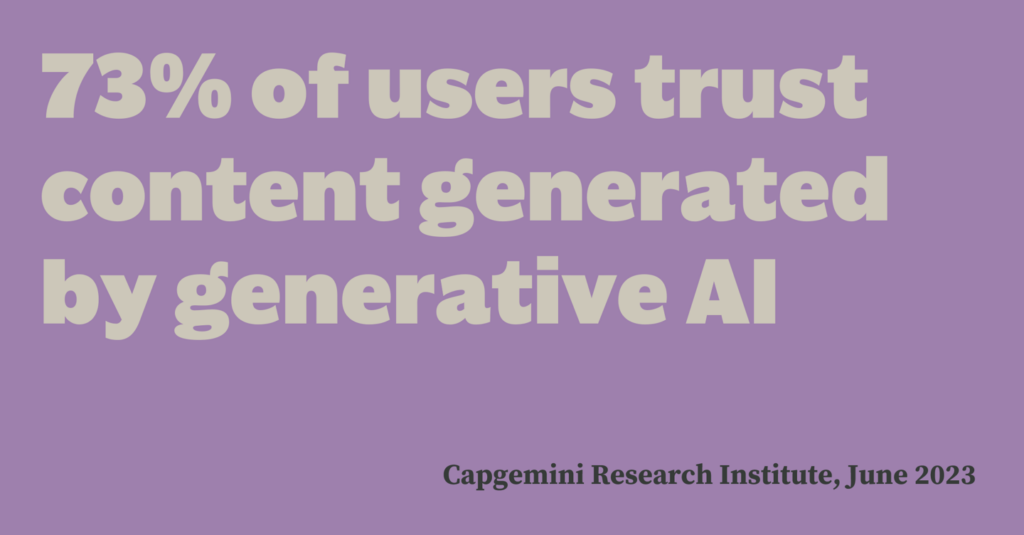
As for legislation and regulation, while it may be in development, progress will be slow and may not fully address the intricacies of AI usage. We believe that it’s time for the communications industry to take the lead in setting its own guidelines for AI usage.
However, despite all the disruption, there is a positive note. AI is already making a substantial positive impact in various domains, from improving cancer screening to addressing climate change, conserving wildlife, and fighting world hunger. The potential for AI to do good is vast and exciting.
How AI can enhance communication accessibility
Our role as communication professionals includes making our communication as effective as possible and ensuring it is accessible to everyone. Currently, fewer than 4% of the world’s top million websites are accessible to people with disabilities. AI can help accelerate progress in this regard by simplifying and enhancing communication:
- Copy simplification with AI editors – Tools like Hemmingway can simplify and improve readability, making communication more accessible.
- AI prompts for readability – Using AI prompts to tailor text for different reading levels, cultures, and languages.
- Digital signing – New platforms in development, like Signapse, will be able to create sign language from text or audio, making communication accessible to people who use sign language.
- Translation – AI can help level up and speed up translation, providing accurate and natural translation, learning from feedback over time.
- Image descriptors – Tools like Verbit can create audio descriptions of images in real-time.
- Text to Speech / Speech to Text – Enhances accessibility for various communication modes.
- Multi-Lingual Chatbots – Assist in multilingual communication.
The importance of AI transparency
During the forum we addressed the significant issue of transparency in AI. We posed thought-provoking questions to the group about transparency and shared considerations for when, how, and whether to be transparent in our AI usage. Our conversations showed that transparency in AI isn’t a straightforward, black-and-white matter; rather, it exists on a spectrum with shades of grey. Determining when to be transparent about our use of AI can pose significant challenges.
Regulation has already driven the need for transparency in various digital domains, such as cookies on websites and advertisements in social media. Just as privacy regulations have mandated the disclosure of cookie usage, AI may could follow a similar path. Users may come to expect clear information about when AI is involved in content generation, and it may be time for communicators to rise to this challenge without the need for legislation.
AI voice cloning
Voice cloning tools use AI and deep learning algorithms to replicate and mimic human voices. These tools analyse the vocal characteristics, pitch, tone, and nuances of a person’s voice from a sample of audio recordings. Once trained, they can generate speech that closely resembles the original speaker’s voice, allowing for the creation of natural-sounding, synthetic voices.
AI voice cloning has numerous applications, from creating realistic voice assistants to generating voiceovers for content. However, it also raises ethical concerns about potential misuse and impersonation, highlighting the need for responsible use and regulation in this rapidly advancing field.
We investigated several voice cloning tools and shared our findings with the group’s attendees. If you’d like to find out more then please reach out.
Navigating AI together: overcoming bias and achieving inclusion
In our next session we will examine the issue of the biases embedded in AI and explore how we can mitigate this bias and harness AI tools to foster greater inclusion and authentic representation.
Let’s continue Navigating AI Together, ensuring responsible, ethical, and inclusive AI usage in our communication practices.





